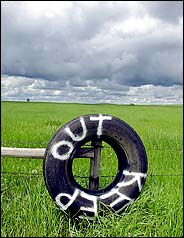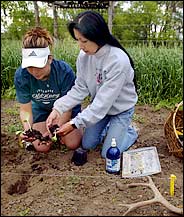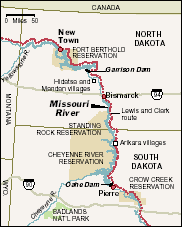


 |
| Keith Meyers/The New York Times |
| The Sioux Indians' Standing Rock Reservation, straddling the Dakotas, on Lewis and Clark's trail. |
 |
| Keith Meyers/The New York Times |
| Amy Mossett, right, with her daughter Nicole Henry is having better success on the same reservation. |
 |
 EW TOWN, N.D. — Indian Country is a place where people gather in late June to celebrate the day Custer was whipped at Little Big Horn, where cars sometimes run only in reverse and casinos run all night, and where a Nez Percé guide who led Lewis and Clark over the Bitterroot Mountains is remembered by his native name, which means "Furnishes White Men With Brains."
EW TOWN, N.D. — Indian Country is a place where people gather in late June to celebrate the day Custer was whipped at Little Big Horn, where cars sometimes run only in reverse and casinos run all night, and where a Nez Percé guide who led Lewis and Clark over the Bitterroot Mountains is remembered by his native name, which means "Furnishes White Men With Brains."
But on the map — be it the road atlas handed out by the state or the statistical one issued by the Census Bureau — the homelands of the first Americans seem to possess little life or magic. Across vast stretches of the northern plains, Indian lands are blank patches, nations within a nation, landlocked islands foreign to most other Americans.
Certainly, the scars of memory are layered as thick as the dam water that buries so many old Indian villages and sacred sites here. Generations after the scourges of smallpox, war and forced resettlement, much of what a traveler finds in Indian Country is emptiness.
Still, those looking to find some link across 200 years, to the people whose nations Lewis and Clark passed through, need only peek into daily life on the reservations along the trail from St. Louis to the Pacific.
Here in New Town, home of the Mandan, Hidatsa and Arikara, Amy Mossett has just planted her garden, using seed corn that is the antithesis of genetically engineered agriculture; it is the same sweet corn given members of the American expedition to help them through the winter of 1804-05, at their fort just down river. At that time, the Indian urban complex 1,600 miles from the mouth of the Missouri River had more people (about 4,000) than St. Louis or Washington.
"Indians have the strongest sense of place of anyone in the world," said Ms. Mossett, a Mandan-Hidatsa who is a scholar on Sacagawea, the young Lemhi Shoshone woman who saved Lewis and Clark from disaster at two points when the expedition was at low ebb. "Look at me: why would I choose to live in little New Town, North Dakota, when I could live anywhere? It's because we've been a part of the Missouri River for a thousand years."
New Town, by its name, raises the question of what happened to Old Town. And this is where the Mandans, who did perhaps more than any other tribe to help Lewis and Clark, turn bitter.
It was one thing for the tribe to lose 90 percent of its members to smallpox, a disease that did more than the United States Cavalry to wipe out American Indians. But in the mid-20th century, just as the population was rebounding, the federal government built the Garrison Dam. It choked off the Missouri River here and buried 155,000 acres of prime Indian farmland under a reservoir, dividing a tight-knit reservation into five districts. Many tribal members wound up in this community, on higher ground.
"Some gratitude, huh?" said Frederick Baker, the Mandan-Hidatsa archivist at the tribal museum here. "One guy I know had his house moved as he was eating dinner. But, hey, we want people to understand our people are alive. Everywhere else in North Dakota, schools are closing and towns are dying. We're growing. We're alive!"
The Corps of Volunteers for North Western Discovery, as Lewis called the expedition, passed through roughly 50 Indian nations in their journey of nearly 8,000 miles. Some of those tribes were forcibly removed to Oklahoma. Others — including the Chinook, who lived at the mouth of the Columbia River on the Pacific Coast — are today without a homeland, even a tiny reservation.
The indignities are piled like bleached buffalo bones. Some of the friendliest tribes were later treated the worst. The Nez Percé, who saved the corps from starvation in Idaho, were chased from their treaty-promised homeland and rounded up near the Canadian border in 1877. The Lemhi Shoshone were erased from the land they had lived on for hundreds of years, and lumped with other tribes in the desert of southern Idaho.
But now as then, big pieces of the trail, particularly in the Dakotas, run through solid Indian Country. These lands hold the bones of Sitting Bull, the great Sioux chief, and of Sacagawea. They contain towns full of heartbreak, where suicide is the No. 1 killer. They also hold prairie grass untouched by the plow, and bison herds roaming free, giving the tribes something to connect pop-culture-jaded teens on the reservation of 2003 to the warriors whose spirit so impressed travelers in 1803.
This year, even the Blackfeet of Montana, the only nation to lose people in mortal conflict with Lewis and Clark, and the aggressive Teton Sioux of the Plains, have the bicentennial.
It is time, the Indians say, to tell their own story of Lewis and Clark, an epic about Indians bailing out whites, showing them where to go, what to eat, whom to avoid along the way, and how to get back home in one piece.
"One reason we're opening our doors to people is because there are so many dumb images of what Indians are like," said Denelle High Elk of the Cheyenne River Sioux Reservation in South Dakota. "I was in Monticello in January, for the kickoff of the bicentennial, and the cab driver said to me, `Oh, you're Indian. You people still live in tepees, don't you?"
Forgotten by History
President Thomas Jefferson knew he was sending an expedition through lands populated by people who did not care a whit for lines drawn on maps in Paris or Virginia. But Jefferson, an Enlightenment-age man, had conflicted views of the native people. He thought some Indians could be "civilized" back East, while others had to be removed to the far Western plains, the continental equivalent of Mars.
"Jefferson appears both as the scholarly admirer of Indian character, archaeology and language, and the planner of cultural genocide, the architect of the removal policy, the surveyor of the Trail of Tears," wrote the historian Anthony F. C. Wallace, in his book, "Jefferson and the Indians: the Tragic Fate of the First Americans."
Lewis and Clark had trouble finding Indians at first. The swift plague of smallpox had come before them, and in some places it left a deathly resonance.
On Aug. 12, 1804, the corps passed the empty village of Tonwantonga, where the once powerful Omahas had lived. Today Nebraska's largest city is named for this tribe, which has a tiny toehold in the state.
Further north lived the Otoe, who joined the Missouri Tribe about 200 years ago. They were the first Indians to have a council with Lewis and Clark.
Today the Otoe and the Missouri have vanished from the trail. They can found in distant Oklahoma, where about 1,300 members live near Red Rock. They feel forgotten by history, some members said, left out of the bicentennial.
But in rummaging through the belongings of a well-traveled tribe, the Otoe found something recently that has electrified historians — two documents written by Meriwether Lewis, which are not in his journal, describing Indians on the middle Missouri.
"My grandmother kept these in her trunk," said Rhoda Dent, treasurer of the tribe. "After she died, my cousin found them. It was just phenomenal for us to read them, even though Lewis refers to native people as children."
The documents are now in the Oklahoma Museum of History, and curators there say they believe they are authentic.
The Otoe would like to reconnect to their old homeland. "We were the first to greet Lewis and Clark, and look what happened to us," Ms. Dent said.
Upriver, the expedition met different reactions among the large nations that roamed the Dakota prairie. Among the Yankton Sioux, the men dined at a tidy village on a meal of stewed dog meat — "good & well-flavored," as one expedition member described it.
William Clark described the Yankton Sioux this way: "Stout bold looking people (the young men hand Sum) and well made. The Warriors are Very much deckerated with porcupin quils & feathers, large legins & mockersons, all with Buffalow roabes of Different colours."
The late historian Stephen Ambrose called such descriptions "pathbreaking ethnology." But the next encounter, with the Teton Sioux, appears to have been a textbook case of diplomatic blundering.
The corps showed off its air gun and a magnifying glass, while offering medals and tobacco. The Teton Sioux, unimpressed, wanted something in return for letting these people pass through their lands. At one point guns were drawn, arrows aimed, and the small cannon mounted to the corps' keelboat ready to fire. The standoff ended peacefully after three days, but with both sides steamed.
Clark never forgot nor forgave. "They are the vilest miscreants of the savage race and must ever remain the pirates of the Missouri," he wrote of the Teton Sioux.
Living Between 2 Worlds
The Sioux fought for their lands to the end, helping to defeat Custer, only to be slaughtered at Wounded Knee in 1890. Today the bands of the Great Sioux Nation, as they call themselves, are spread throughout South Dakota, while Jefferson's granite visage is carved near an Indian sacred site in the Badlands.
They have shown the same fierce spirit in taking hold of the Lewis and Clark bicentennial in their state, despite opposition from some Sioux elders, and some initial snubs from other tribes. The Sioux have organized an intertribal tourism council, and set up a Native American Scenic Byway — "a journey through the lands of the least known and most misunderstood nations in America," as the Indians say in a brochure for the road and its highlights.
"We were entrepreneurs back then," said Daphne Richards Cook, who lives on the Lower Brule Sioux Reservation in South Dakota. "And we're entrepreneurs now."
The reservations are breathtaking, the prairie grass high and green, the towns bursting with one quirky story after another. They are the biggest population centers for hundreds of miles, with 12,000 Indians living on the Cheyenne River Reservation, 11,000 on the Standing Rock, and 4,300 total on the smaller Crow Creek and Lower Brule reservations. One out of every 12 people in South Dakota, population 756,600, is Indian.
"I call Indian Country the last of the real frontier," said Wanda Wells Crowe of the Crow Creek Sioux. "Take a look — it's not your typical America."
The Sioux say they walk a fine line between two worlds. "A lot of Indians don't want people here," Ms. Crowe said. "And in truth, I sometimes wonder myself why I'm doing this, trying to promote Lewis and Clark as a way to tell our story." Perhaps the greatest cross-cultural mingling on the expedition happened in what is now North Dakota, where the corps wintered just across the river from Mandan and Hidatsa villages. Lewis and Clark spent more time in the area than anywhere else.
What the natives who descended from those tribes want people to know is that they already had an advanced society when Lewis and Clark arrived. It was a sophisticated agricultural society, with clans and large earth lodges run by women. The Indians shared food, building tips and wives with the newcomers.
"Jefferson wanted to make Indians into farmer and traders," Ms. Mossett said between bites of a fajita salad at a restaurant here in New Town. "But we were already doing all of that. The difference is, we were doing it without slave labor."
Of course, the Mandan and Hidatsa captured other Indians in raids, and later adopted them into their culture. That is how Sacagawea came to live with the Mandan and Hidatsa. She joined the corps in the winter, just after giving birth to a boy she would carry across the West and back.
"In some ways, the Hidatsa thought these guys were a joke," said Mr. Baker, the museum archivist. "We saw them as a trading opportunity, but also felt sorry for them. And we joked about their crummy trade items."
Farther along the trail, the Nez Percé also pitied the corps. At one point, the explorers might have been killed just after crossing the Continental Divide, but a Nez Percé woman intervened.
"The expedition owed more to Indian women than either captain ever acknowledged," Mr. Ambrose wrote in "Undaunted Courage," his best-selling account of the voyage. Mr. Ambrose also noted the bitter irony that when the Nez Percé were driven out of their homeland in 1877, among the stragglers were a handful of old men who had been children when Lewis and Clark visited.
The Nez Percé, alone among American Indian tribes, selectively bred horses, and say they produced the appaloosa. On this bicentennial, the tribe is reviving its horse-breeding registry and language as part of a Lewis and Clark Rediscovery Project.
A sign on the Weippe Prairie, in Idaho, reads: "Lewis and Clark Route, First Contact Between Two Cultures."
Like the Sioux, the Nez Percé, with 3,296 tribal members today, suffered the indignity of not even being called by their real name. Sioux is a Chippewa word, shortened by the French, which means little snake, or enemy. Nez Percé is also a French misnomer. Tribal members say they did not pierce their noses.
At the very least, the Nez Percé, like other Indians along the route from the flatlands to the ocean, hope the Lewis and Clark bicentennial will dispel certain myths.
With the kind of humor found often in Indian Country, the tribe is taking to the revisionist task. After discussing efforts to restore salmon in rivers stapled with government dams, the Nez Percé report on their Web site that "we also frequent restaurants and eat modern foods."